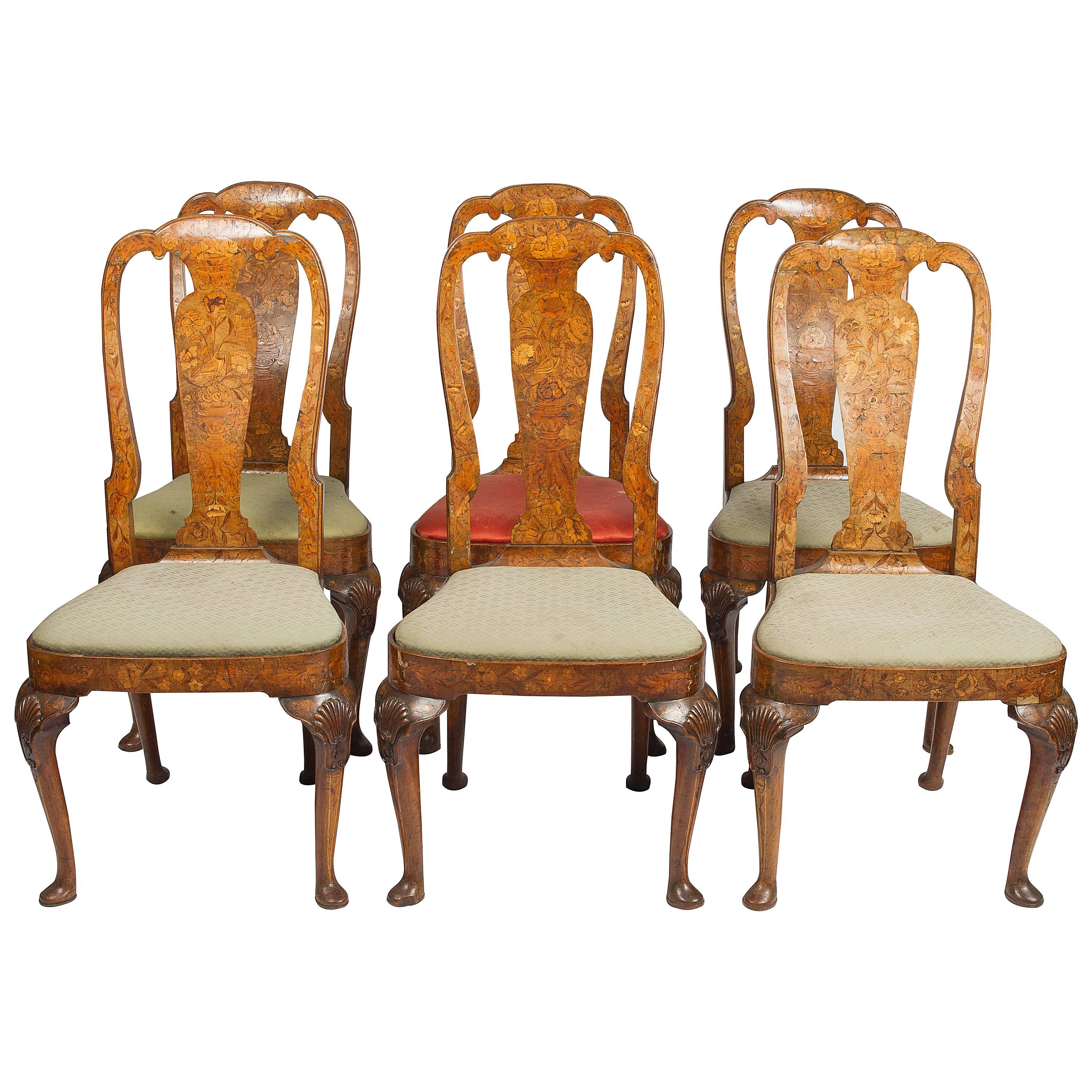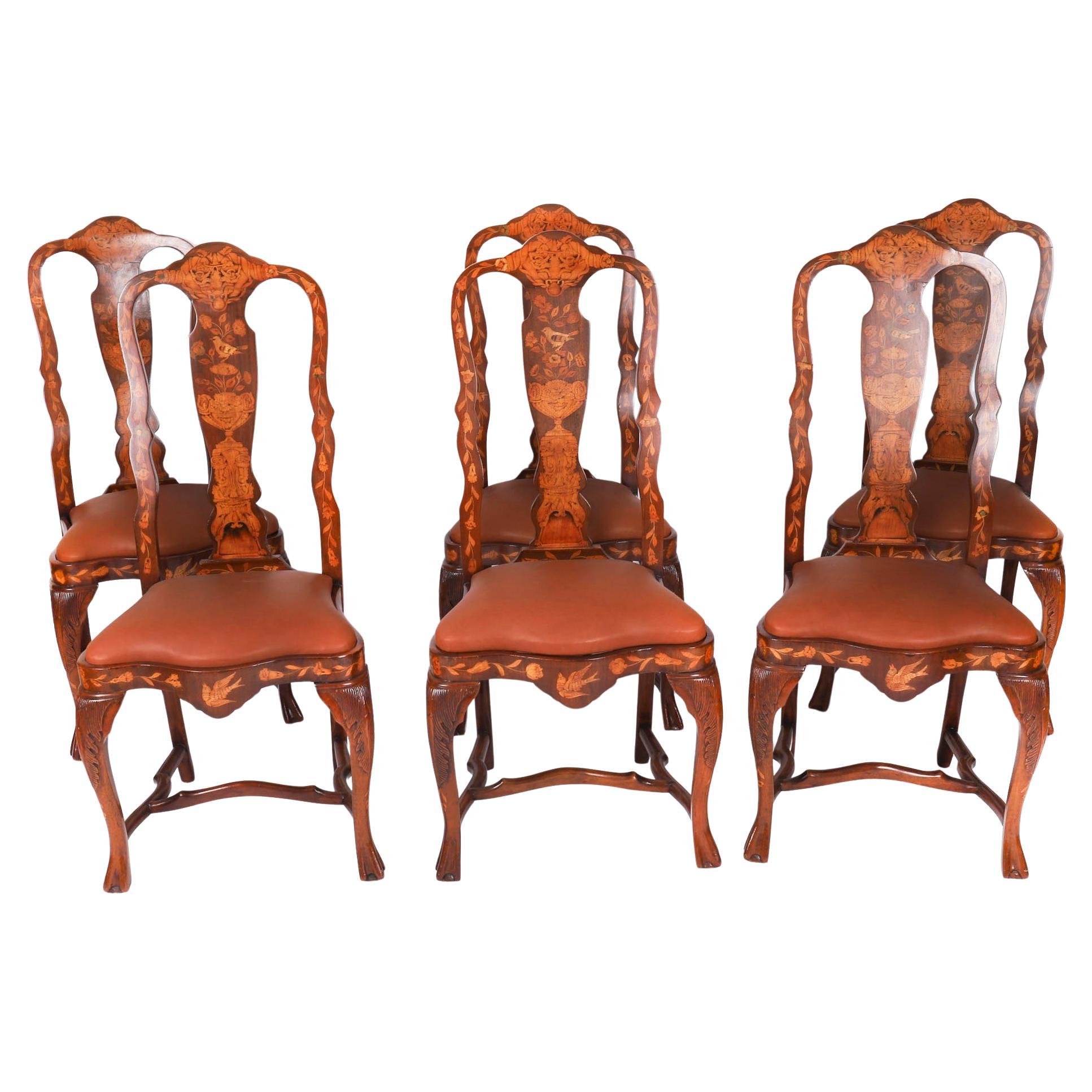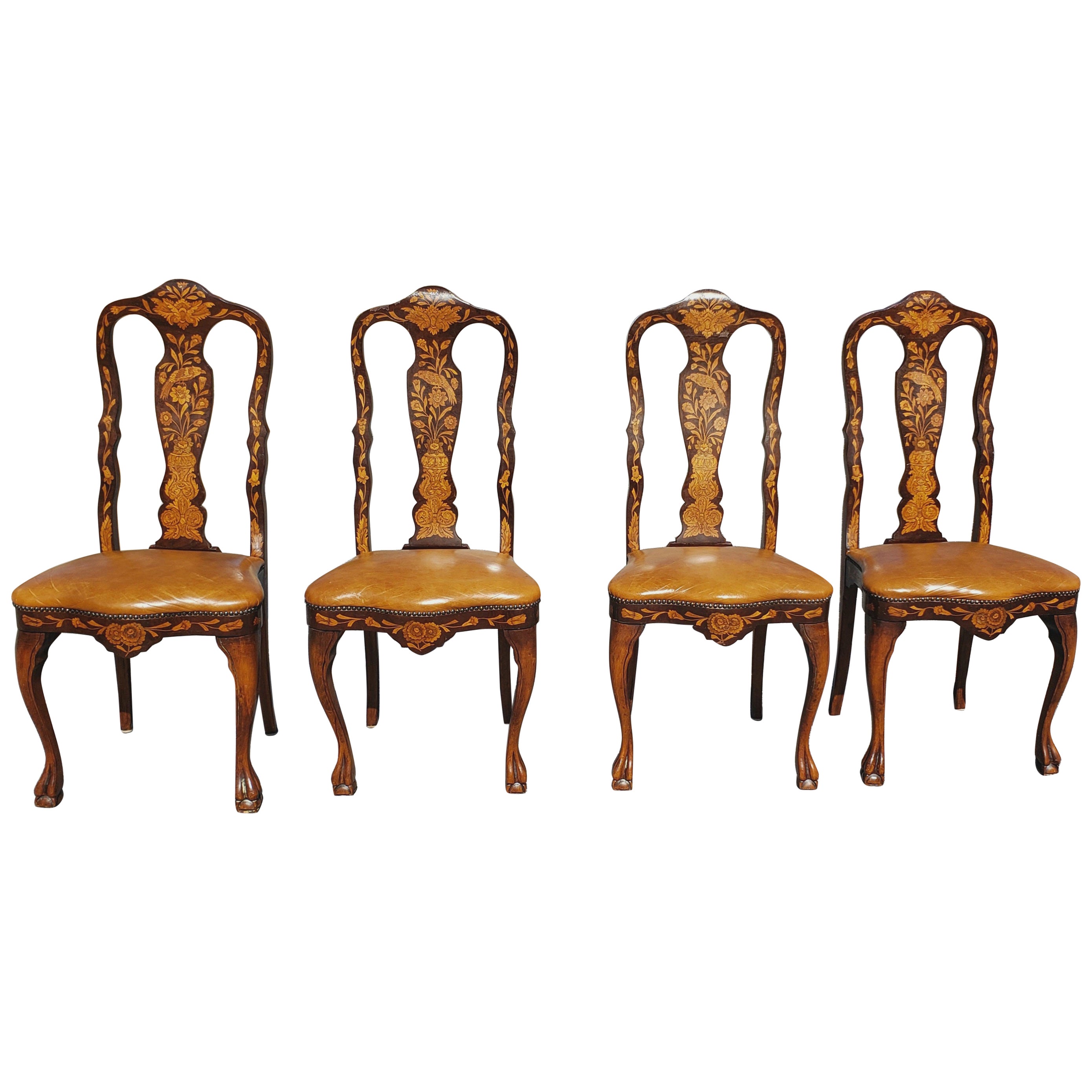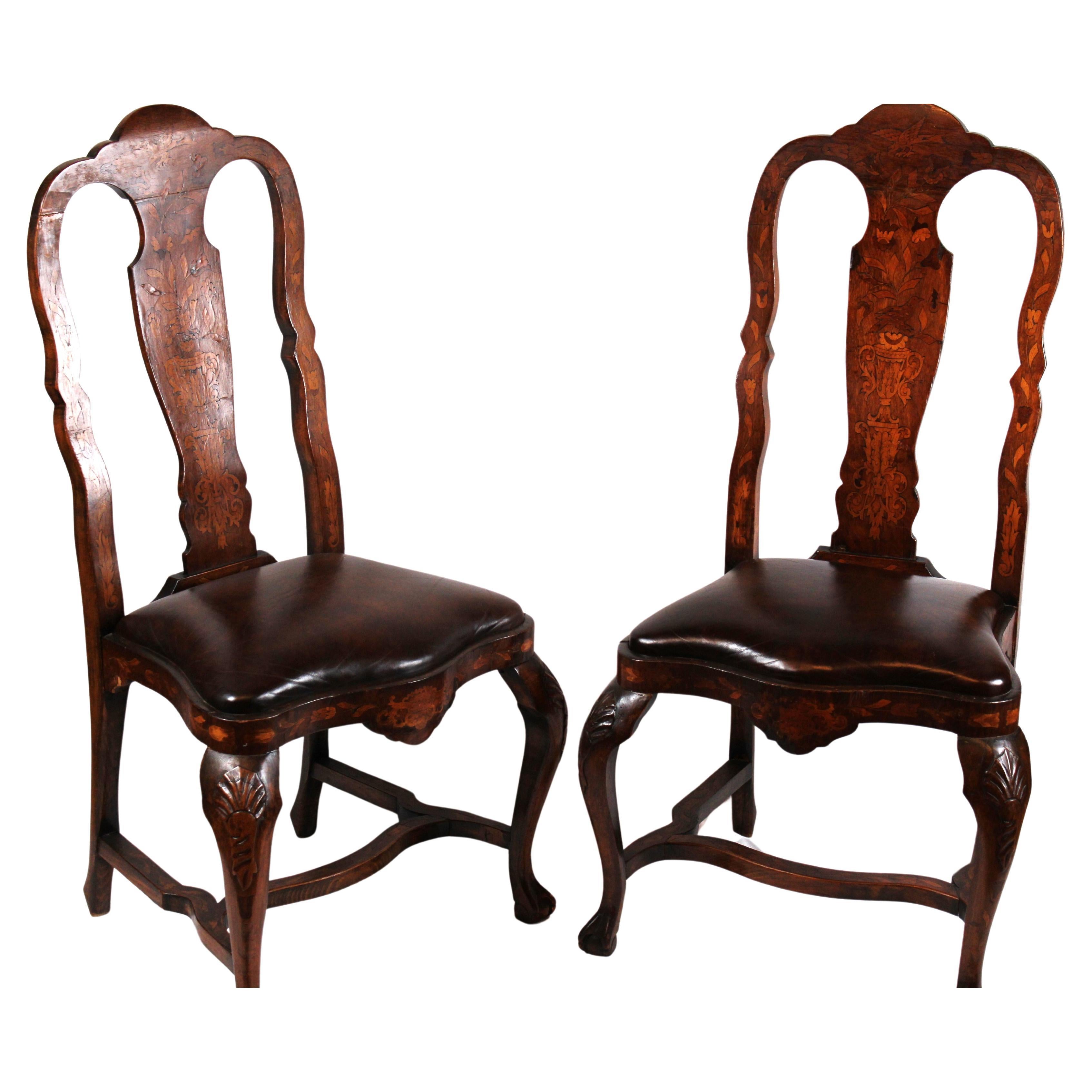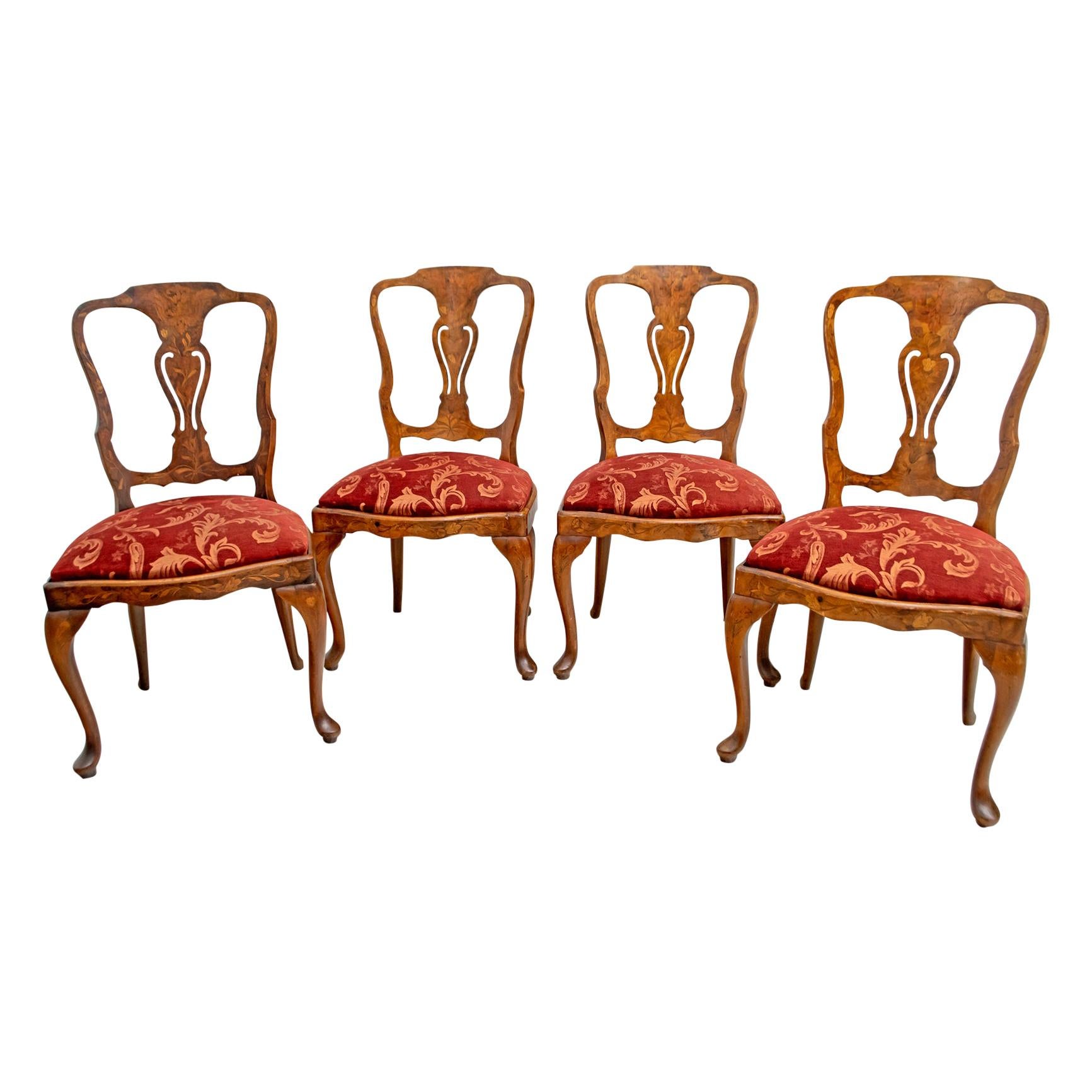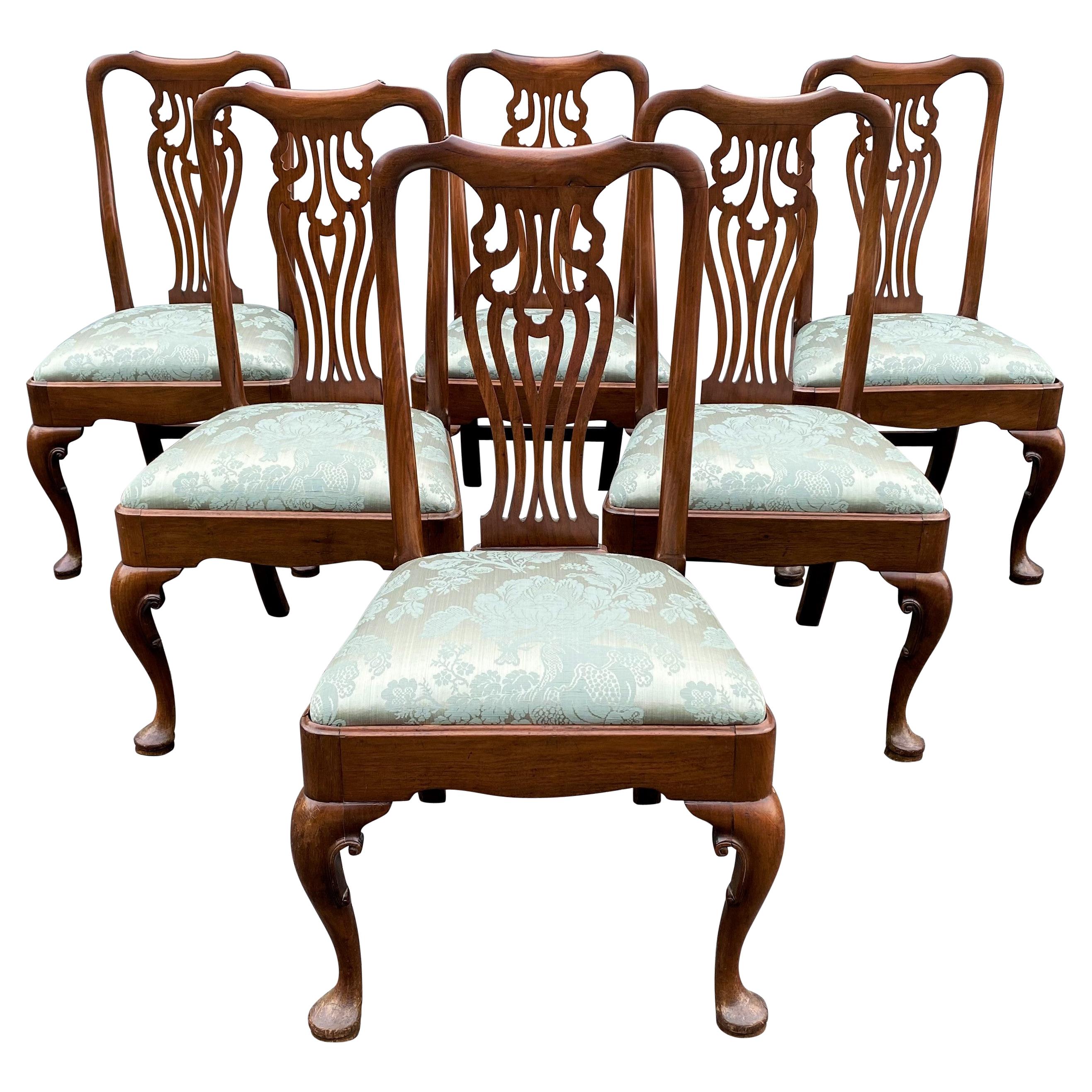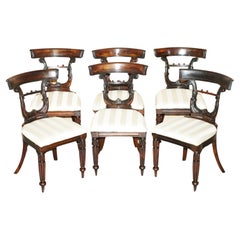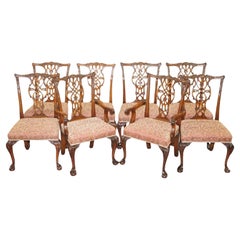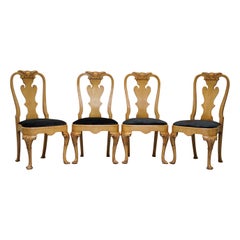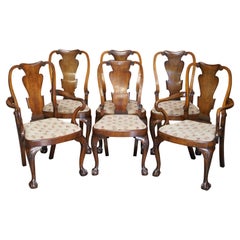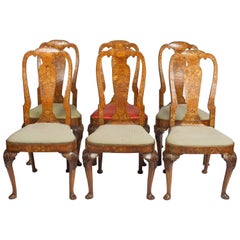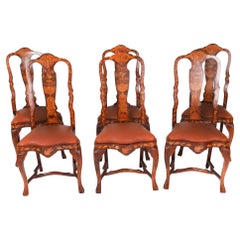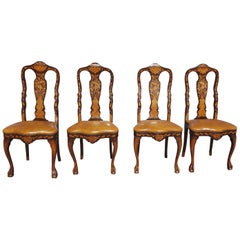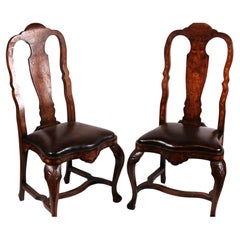Items Similar to Rare Set of Six 18th Century circa 1760 Dutch Elm Marquetry Inlaid Dining Chairs
Want more images or videos?
Request additional images or videos from the seller
1 of 21
Rare Set of Six 18th Century circa 1760 Dutch Elm Marquetry Inlaid Dining Chairs
$10,655.83per set
$13,319.79per set20% Off
£7,600per set
£9,500per set20% Off
€9,030.02per set
€11,287.52per set20% Off
CA$14,542.15per set
CA$18,177.69per set20% Off
A$16,194per set
A$20,242.50per set20% Off
CHF 8,428.08per set
CHF 10,535.10per set20% Off
MX$199,670.03per set
MX$249,587.54per set20% Off
NOK 107,338.05per set
NOK 134,172.57per set20% Off
SEK 100,887.36per set
SEK 126,109.21per set20% Off
DKK 67,375.14per set
DKK 84,218.92per set20% Off
Shipping
Retrieving quote...The 1stDibs Promise:
Authenticity Guarantee,
Money-Back Guarantee,
24-Hour Cancellation
About the Item
We are delighted to offer for sale this stunning and exceptionally rare set of six totally original 18th century circa 1760 hand carved Dutch Elm Marquetry inlaid dining chairs
These chairs are exceptionally well made and highly collectable, its very rare to find an original set of six, they usually turn up as singles or a pair. These are ornately carved all over with birds and flowers, the timber is Elm with Walnut inlay
We have cleaned waxed and polished the suite from top to bottom. In terms of the condition the chairs are all strong and stable, the frames have been checked and secured, the upholstery is new. There will be age related patina marks all over and some small timber losses, nothing you wouldn’t expect from 260+ year old chairs.
Dimensions:
Height 105.5cm, seat height 46cm
Width 50.5cm
Depth 52cm
Please note all measurements are taken at the widest point
This item is available for collection from our Wimbledon warehouses
Condition
Please view the very detailed pictures as they form part of the description around condition
Please note vintage period and original items such as leather seating will always have natural patina in the form of cracking creasing and wear, we recommend regular waxing to ensure no moisture is lost, also hand dyed leather is not recommended to sit in direct sunlight for prolonged periods of time as it will dry out and fade.
- Dimensions:Height: 41.54 in (105.5 cm)Width: 19.89 in (50.5 cm)Depth: 20.48 in (52 cm)Seat Height: 18.12 in (46 cm)
- Sold As:Set of 6
- Style:George III (Of the Period)
- Materials and Techniques:
- Place of Origin:
- Period:1760-1769
- Date of Manufacture:1760
- Condition:Wear consistent with age and use. Minor structural damages. Minor fading.
- Seller Location:West Sussex, GB
- Reference Number:1stDibs: LU2823318635962
About the Seller
4.7
Platinum Seller
Premium sellers with a 4.7+ rating and 24-hour response times
Established in 2012
1stDibs seller since 2017
1,984 sales on 1stDibs
Typical response time: 1 hour
- ShippingRetrieving quote...Shipping from: West Sussex, United Kingdom
- Return Policy
Authenticity Guarantee
In the unlikely event there’s an issue with an item’s authenticity, contact us within 1 year for a full refund. DetailsMoney-Back Guarantee
If your item is not as described, is damaged in transit, or does not arrive, contact us within 7 days for a full refund. Details24-Hour Cancellation
You have a 24-hour grace period in which to reconsider your purchase, with no questions asked.Vetted Professional Sellers
Our world-class sellers must adhere to strict standards for service and quality, maintaining the integrity of our listings.Price-Match Guarantee
If you find that a seller listed the same item for a lower price elsewhere, we’ll match it.Trusted Global Delivery
Our best-in-class carrier network provides specialized shipping options worldwide, including custom delivery.More From This Seller
View AllSIX GILLOWS OF LANCASTER ATTRIBUTED ANTIQUE HARDWOOD REGENCY 1810 DINING CHAIRs
By Gillows of Lancaster & London
Located in West Sussex, Pulborough
Royal House Antiques
We are delighted to offer this important suite of museum quality, antique Colonial Gillows of Lancaster Attributed solid Rosewood dining chairs with ornately carved back splats
Please note the delivery fee listed is just a guide and covers London only for the UK and local Europe for the rest of the world, if you are outside of this area please send me your address and I will provide you with an accurate quote
Where to begin, if you’re looking at this listing then the chances are you know exactly how significant this suite is, Gillows of Lancaster & London was simply put, one of the most important furniture designers in the history of England, these chairs are the only Colonial examples I have ever seen and in Rosewood no less, they weigh roughly three times more than a standard dining chair of the same style and size, they are very substantial
The chairs early 19th century circa 1810-1820, the carving is exquisitely executed and the chairs look sophisticated and elegant from all angles
The suite has been sympathetically restored to include a deep clean, hand condition wax and hand polish, the seat covers have been left as they are, they are fine, the timber has a wonderfully aged patina that is honestly sublime
Dimensions
Height:- 81cm
Width:- 45cm
Depth:- 50cm
Seat height:- 44cm
Please note all measurements are taken at the widest point.
Lot Essay
These chairs are closely related to those in two recognised Chippendale commissions: Sir Gilbert Heathcote (d. 1785), 3rd Baronet for Normanton Hall, Rutland and William Crichton-Dalrymple, 5th Earl of Dumfries (4th Earl of Stair, 1699-1768) for Dumfries House, Ayrshire.
THE RELATED CHAIRS
The chairs are of identical decoration to the set of two armchairs and ten single chairs, circa 1765, formerly at Normanton Hall (1). In 1759, Sir Gilbert Heathcote (d. 1785), 3rd Baronet, succeeded to the vast inheritance established by his grandfather, also Gilbert, 1st Baronet (1652-1733), who was reputed to be ‘the richest commoner in England’ (2). The 3rd Baronet employed both Chippendale Senior and his son, Chippendale Junior, in the furnishing of his Palladian mansion, Normanton Hall in Rutland, and his London houses, 29 Grosvenor Square, London and Browne's House at North End, Fulham. Surviving Chippendale accounts, although incomplete, show that the firm was working periodically for members of the Heathcote family from 1768 to 1821. Most of the furniture listed in these accounts was intended for Browne’s House, although after 1798 when the family relinquished this residence some of the furniture was moved to Normanton Hall. The latter was sold in 1924, and any furniture not included in the Normanton Hall sale was taken to the Earl of Ancaster’s seat at Grimsthorpe Castle, Lincolnshire. Chippendale’s earliest invoice for Sir Gilbert Heathcote records the acquisition in 1768 of ‘6 India Back and arm chairs Japand to imitate the Bamboe’, signifying how the family embraced the highly fashionable chinoiserie taste. Although the Normanton chairs cannot be conclusively identified in the extant Chippendale accounts, their form and ornamentation led Christopher Gilbert to suggest that they were possibly by Chippendale (3).
The set of four mahogany chairs at Dumfries House have nearly-identical pagoda-form cresting rails and identical terminals but differ in the arrangement of the 'Chinese' paling in the backs and side panels. Although no documentary evidence for the Dumfries chairs survives, in their execution and sophisticated carving of the toprails, they are extremely close to Chippendale’s hand.
Another near-set of closely related chairs is at Saltram House, Devon, where Chippendale worked between 1771-2; these dates are based on payments in John Parker's cash account book, and probably do not reflect a true picture of the entire commission as Parker often paid tradesmen by banker's draft (4). Comprising two armchairs and seven single chairs, this set, circa 1765, is made of padouk, and has been described by the National Trust as ‘Chinese Export’ (5). The set was returned to Saltram in 1951 having been accepted by H.M. Treasury in lieu of full payment of Death Duty from the Executors of Edmund Robert Parker, 4th Earl of Morley (1877-1951). Some of the chairs are currently on display in ‘The Chinese Chippendale Bedroom’.
A further set of four padouk chairs of the Saltram pattern was almost certainly at Kenwood House, London; some of these are recorded in 18th century inventories drawn up by Lord Mansfield. This set was removed to Scone Palace, Perth, prior to the auction at Kenwood in 1922, and subsequently sold from ‘Scone Palace and Blairquhan: The Selected Contents of Two Great Scottish Houses’, Christie’s, London, 24 May 2007, lot 298.
Another pair of padouk chairs of this model sold ‘The Collection of Peggy and David Rockefeller’, Christie’s, New York, 10 May 2018, lot 647 ($193,750 inc. premium).
THE DESIGN
Conceived in the Chinese manner expounded by William and John Halfpenny in Rural Architecture in the Chinese Taste (1752), and Sir William Chambers in his Designs of Chinese Buildings, Furniture, Dresses, Machines and Utensils (1757), the pattern for this set of ‘Pagoda’ chairs relates to nine designs for ‘Chinese Chairs’ in the 1st edition of Chippendale’s Director (1754); the cabinet-maker describes these designs thus:
Plates XXIII, XXIV and XXV are nine Chairs in the present Chinese manner, which I hope will improve that taste, or manner of work; it having yet never arrived to any perfection; doubtless it might be lost without feeling its beauty: as it admits of the greatest variety, I think it the most useful of any other. The sizes are all specified on the designs. The three last (No. XXV.) I hope will be well received, as there has been none like them yet made.
The Georgian period witnessed the proliferation of such railed and pagoda-crested chairs in both the ‘picturesque’ Chinese tea pavilions of landscaped parks as well as in fashionable apartments hung with ‘India’ paper. The geometric ‘Chinese’ feet of these chairs are also found on a set of pedestals...
Category
Antique 1810s English George III Dining Room Chairs
Materials
Hardwood
$7,795 Sale Price / set
20% Off
Set of Eight Solid Hardwood Claw & Ball Feet Thomas Chippendale Dining Chairs 8
By Thomas Chippendale
Located in West Sussex, Pulborough
We are delighted to offer for sale this sublime suite of eight vintage ornately hand carved Mahogany dining chairs after the original by Thomas Chippendale
These chairs are amazing,...
Category
20th Century English Chippendale Dining Room Chairs
Materials
Upholstery, Hardwood
$6,730 Sale Price / set
20% Off
Stunning Set of Four Walnut Queen Anne Dining Chairs Acanthus Leaf Carved Wood
Located in West Sussex, Pulborough
We are delighted to offer for sale this stunning set of four circa 1900 walnut Queen Anne dining chairs with black crushed velvet velour upholstery
A very good looking and decorat...
Category
Antique Early 1900s English Queen Anne Dining Room Chairs
Materials
Walnut
$1,682 Sale Price / item
20% Off
Six Victorian 1880 Walnut Shepherds Crook Dining Chairs with Claw & Ball Feet
Located in West Sussex, Pulborough
We are delighted to offer this lovely suite of six original Victoria Walnut framed cabriolet legged dining chairs with Claw & Ball feet and Shepherds crook curved arms
Please note...
Category
Antique 1880s English High Victorian Dining Room Chairs
Materials
Walnut
$3,365 Sale Price / set
20% Off
FOUR ANTIQUE COLONIAL THOMAS CHIPPENDALE HARDWOOD FRET WORK CARVED DiNING CHAIRS
By Thomas Chippendale
Located in West Sussex, Pulborough
Royal House Antiques
We are delighted to offer this important suite of museum quality, antique Colonial Rosewood Thomas Chippendale, fret work carved dining chairs
Please note the delivery fee listed is just a guide and covers London only for the UK and local Europe for the rest of the world, if you are outside of this area please send me your address and I will provide you with an accurate quote
Where to begin, if you’re looking at this listing then the chances are you know exactly how significant this suite is, Thomas Chippendale was simply put, the most important furniture designer in history, these chairs are the only Colonial examples I have ever seen and in Rosewood no less, they weigh roughly three times more than a standard dining chair of the same style and size, they are very substantial
The chairs are late 19th century circa 1880-1900, they are of course based on the original 18th century examples, the carving is exquisitely executed and the chairs look sophisticated and elegant from all angles
The suite has been sympathetically restored to include a deep clean, hand condition wax and hand polish, the seat covers have been left as they are, they are ok, I can have them reupholstered for the cost price to anything the new owners wish
Literature
Two chairs illustrated in Tabellenbuch Holztechnik, Hamburg, 2013, p. 271.
Exhibited
Ten chairs on loan to Birmingham Museums circa 1985-2010 and exhibited at Aston Hall, Birmingham, where photographed in situ..
Dimensions
Height:- 93cm
Width:- 56cm
Depth:- 53cm
Seat height:- 47cm
Please note all measurements are taken at the widest point.
Lot Essay
These chairs are closely related to those in two recognised Chippendale commissions: Sir Gilbert Heathcote (d. 1785), 3rd Baronet for Normanton Hall, Rutland and William Crichton-Dalrymple, 5th Earl of Dumfries (4th Earl of Stair, 1699-1768) for Dumfries House, Ayrshire.
THE RELATED CHAIRS
The chairs are of identical decoration to the set of two armchairs and ten single chairs, circa 1765, formerly at Normanton Hall (1). In 1759, Sir Gilbert Heathcote (d. 1785), 3rd Baronet, succeeded to the vast inheritance established by his grandfather, also Gilbert, 1st Baronet (1652-1733), who was reputed to be ‘the richest commoner in England’ (2). The 3rd Baronet employed both Chippendale Senior and his son, Chippendale Junior, in the furnishing of his Palladian mansion, Normanton Hall in Rutland, and his London houses, 29 Grosvenor Square, London and Browne's House at North End, Fulham. Surviving Chippendale accounts, although incomplete, show that the firm was working periodically for members of the Heathcote family from 1768 to 1821. Most of the furniture listed in these accounts was intended for Browne’s House, although after 1798 when the family relinquished this residence some of the furniture was moved to Normanton Hall. The latter was sold in 1924, and any furniture not included in the Normanton Hall sale was taken to the Earl of Ancaster’s seat at Grimsthorpe Castle, Lincolnshire. Chippendale’s earliest invoice for Sir Gilbert Heathcote records the acquisition in 1768 of ‘6 India Back and arm chairs Japand to imitate the Bamboe’, signifying how the family embraced the highly fashionable chinoiserie taste. Although the Normanton chairs cannot be conclusively identified in the extant Chippendale accounts, their form and ornamentation led Christopher Gilbert to suggest that they were possibly by Chippendale (3).
The set of four mahogany chairs at Dumfries House have nearly-identical pagoda-form cresting rails and identical terminals but differ in the arrangement of the 'Chinese' paling in the backs and side panels. Although no documentary evidence for the Dumfries chairs survives, in their execution and sophisticated carving of the toprails, they are extremely close to Chippendale’s hand.
Another near-set of closely related chairs is at Saltram House, Devon, where Chippendale worked between 1771-2; these dates are based on payments in John Parker's cash account book, and probably do not reflect a true picture of the entire commission as Parker often paid tradesmen by banker's draft (4). Comprising two armchairs and seven single chairs, this set, circa 1765, is made of padouk, and has been described by the National Trust as ‘Chinese Export’ (5). The set was returned to Saltram in 1951 having been accepted by H.M. Treasury in lieu of full payment of Death Duty from the Executors of Edmund Robert Parker, 4th Earl of Morley (1877-1951). Some of the chairs are currently on display in ‘The Chinese Chippendale Bedroom’.
A further set of four padouk chairs of the Saltram pattern was almost certainly at Kenwood House, London; some of these are recorded in 18th century inventories drawn up by Lord Mansfield. This set was removed to Scone Palace, Perth, prior to the auction at Kenwood in 1922, and subsequently sold from ‘Scone Palace and Blairquhan: The Selected Contents of Two Great Scottish Houses’, Christie’s, London, 24 May 2007, lot 298.
Another pair of padouk chairs of this model sold ‘The Collection of Peggy and David Rockefeller’, Christie’s, New York, 10 May 2018, lot 647 ($193,750 inc. premium).
THE DESIGN
Conceived in the Chinese manner expounded by William and John Halfpenny in Rural Architecture in the Chinese Taste (1752), and Sir William Chambers in his Designs of Chinese Buildings, Furniture, Dresses, Machines and Utensils (1757), the pattern for this set of ‘Pagoda’ chairs relates to nine designs for ‘Chinese Chairs’ in the 1st edition of Chippendale’s Director (1754); the cabinet-maker describes these designs thus:
Plates XXIII, XXIV and XXV are nine Chairs in the present Chinese manner, which I hope will improve that taste, or manner of work; it having yet never arrived to any perfection; doubtless it might be lost without feeling its beauty: as it admits of the greatest variety, I think it the most useful of any other. The sizes are all specified on the designs. The three last (No. XXV.) I hope will be well received, as there has been none like them yet made.
The Georgian period witnessed the proliferation of such railed and pagoda-crested chairs in both the ‘picturesque’ Chinese tea pavilions of landscaped parks as well as in fashionable apartments hung with ‘India’ paper. The geometric ‘Chinese’ feet of these chairs are also found on a set of pedestals...
Category
Antique 1880s English Victorian Dining Room Chairs
Materials
Hardwood
$16,825 Sale Price / set
20% Off
FOUR EXQUISITE ANTIQUE ViCTORIAN JAS SHOOLBRED RETAILED HARDWOOD DINING CHAIRS
By Jas Schoolbred
Located in West Sussex, Pulborough
Royal House Antiques
Royal House Antiques is delighted to offer for sale this stunning suite of four Circa 1880 Jas Shoolbred retailed, Rosewood Italian inlaid dining...
Category
Antique 1880s Italian Victorian Dining Room Chairs
Materials
Hardwood
$2,635 Sale Price / set
20% Off
You May Also Like
Set of Six 18th Century Dutch Marquetry Chairs
Located in Brighton, Sussex
A good quality set of six 18th century Dutch marquetry chairs, each having flowers, leaves, birds and urns inlaid to the backs and apron. Drop i...
Category
Antique 18th Century Dutch Side Chairs
Materials
Walnut
$13,319 / set
Antique Set 6 Dutch Marquetry Walnut High Back Dining Chairs Late 18th Century
Located in London, GB
This is a wonderful and rare antique set of six high backed Dutch walnut and floral marquetry dining chairs, Circa 1780 in date.
The set comprises six side chairs that have been ski...
Category
Antique Late 18th Century Dutch Dining Room Chairs
Materials
Leather, Walnut
Set of 4 Dutch Marquetry Mahogany Satinwood and Leather Seat Dining Chairs
Located in Germantown, MD
This exquisite set of four mahogany and satinwood Ducth marquetry dining chairs with top and soft grain leather seats offer a sophisticated presence for any upscale home. Newer, solf...
Category
Antique Late 19th Century Italian Rococo Revival Dining Room Chairs
Materials
Leather, Fruitwood, Mahogany, Satinwood
$8,050 Sale Price / set
30% Off
Elegance in Wood: 19th-Century Dutch Marquetry Dining Chairs (Set of 6)
Located in Austin, TX
This remarkable 19th-century Dutch dining chair seamlessly blends artistry and functionality. Crafted from rich walnut, it stands as a testament to the skilled hands that shaped it.
...
Category
Antique 19th Century Dutch Queen Anne Dining Room Chairs
Materials
Mahogany, Olive, Satinwood, Walnut
$3,600 Sale Price / set
20% Off
Walnut Dutch Chairs of the 20th Century with Maple Wood Inlays, Netherlands
Located in Puglia, Puglia
4 Dutch chairs from the Mid-20th Century. Exceptional quality chairs, richly inlaid in walnut and maple. The upholstery has been redone in worked velvet, partially restored and polis...
Category
20th Century Dutch Dutch Colonial Dining Room Chairs
Materials
Maple, Walnut, Velvet
$2,022 Sale Price / set
30% Off
Set of Six 18th Century Queen Anne Walnut Dining or Side Chairs
Located in Milford, NH
An exceptional set of six Queen Anne walnut dining or side chairs with hand carved reticulated splats and front cabriole legs terminating with pad feet. The slip seats have been rece...
Category
Antique 18th Century English Queen Anne Dining Room Chairs
Materials
Damask, Walnut
